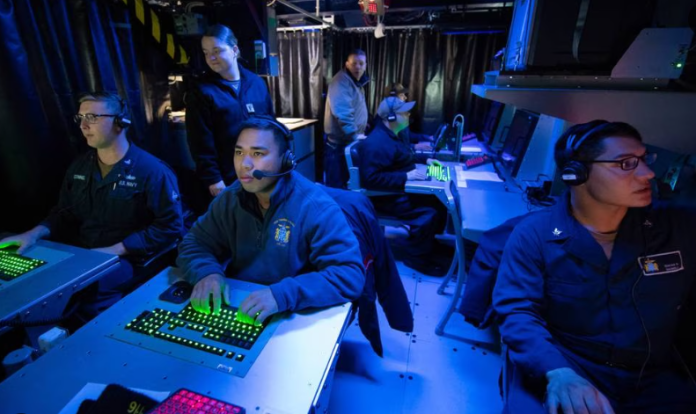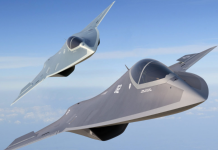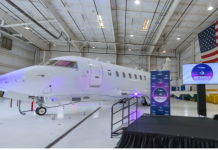The Navy has revealed little about its contribution to the Defense Department’s joint all-domain command and control initiative but has started experimenting with systems that will bring the concept to life at sea, service leaders say.
The Army has held annual Project Convergence experiments and Air Force leadership has openly discussed its plans for the Advanced Battle Management System, but the Navy has remained tight-lipped about Project Overmatch, the service’s component of the JADC2 initiative to connect sensors to shooters across all warfighting domains.
The aim of Project Overmatch is to “create a more interoperable force, allowing more pieces of the Navy — more ships, more aircraft, more unmanned systems later on — to be able to connect with one another and talk to one another, using the Navy’s wildly diverse collection of communication systems,” said Bryan Clark, a senior fellow at Hudson Institute.
Like the other services, the Navy has a variety of communication systems that are not necessarily interoperable, “and you have to create gateways that connect them together, or you’ve got to put multiple radios on everything in the force to be able to allow them to communicate,” Clark said in an interview. “What Project Overmatch is designed to do is” use software to translate “automatically between different communication systems,” he said.
Once operational, Project Overmatch will ultimately flow into a “joint command structure,” said Rear Adm. Doug Small, the commander of Naval Information Warfare Systems Command and the program manager for Project Overmatch. But while the “joint” part of JADC2 is important, each service faces different command-and-control challenges, he said.
“The operational architecture that we’re developing … is all about naval power on behalf of the Joint Force,” Small said during a panel discussion at the Navy League’s Sea-Air-Space conference in April. “That’s what the project is about. I can’t get into specifics — only thing I can say is that each service has unique needs for how to command and control forces” in the operating environment.
“It still comes down to the art of command and control, and what it is that we provide architecturally to allow those commanders at all levels to be able to exercise” that capability, he said. “It’s joint, it’s all-domain, but it comes down to … command and control.”
Chief of Naval Operations Adm. Michael Gilday said the Navy is testing technologies related to the project on the Carl Vinson Carrier Strike Group off the coast of California. The experiment currently involves “about eight ships, across many different networks and many different types of data,” Gilday said during a panel discussion hosted by the Brookings Institution in June.
For fiscal year 2023, the Navy received $226 million in research-and-development funding for Project Overmatch, and the service is requesting $192 million for fiscal year 2024, according to service budget documents.
The testing with the Vinson strike group is the “starting gun” for Project Overmatch, Small said. “What we’re learning, without getting into specifics on the technologies and things, it’s hard,” Small said at the conference. No matter the system, introducing new capabilities across the entire service is one of the hardest things to do, he said.
The Navy is taking an “incremental approach” with Project Overmatch, he said. “You can’t create a whole new job series in the Navy to be able to operate the system and expect to do that” all at once. “So, you got to figure out, how are we going to do this … and do it inside of the cycles that the Navy has for how we build readiness?”
One capability that the service has transitioned to that will play a key role in Project Overmatch is “over-the-air software delivery,” he said. That is preferable to waiting for a ship to come in to port to make upgrades. “So, now it’s no longer, ‘Hey, in two years we’ll be back’” with software updates; those upgrades can be introduced that day, he said.
When speaking to industry about what is needed for Project Overmatch, the message is simple: “We just want your software,” Small said.
Clark said operators have previously used physical gateways carried by aircraft where one radio is essentially bolted to another radio, “and you basically have the output of one go in to become the input of the other,” he said. “It’s a very kind of rudimentary way of allowing two different communication systems to connect to one another,” and for Project Overmatch the Navy is trying to use software instead.
“You can have one software-defined radio that has multiple card slots in it that allows [you to] use different waveforms,” he said. “The radio is able to handle the different waveforms of the different communication systems, and then software inside the radio translates the message from one format into the other format.
“From the operator’s perspective, it’s kind of transparent: you’re connecting with the guy you needed to connect with and the message is being routed in a way that you both understand, but in reality, you’re both on two completely different communication networks,” he said.
The technology works similarly to civilian communication networks today, Clark said.
“When I pick up my [Voice over Internet Protocol] phone … to call you, when I talk into the phone that’s analog, and then it turns immediately into a digital signal, and then when it leaves my phone, it’s ones and zeros,” he said. “And then when it goes to the phone network, to the mobile phone via the cell tower, then it gets re-turned into a waveform that you then receive as electromagnetic energy. … So, what the Navy is doing is simply adopting that same technology to say, ‘Well if everything once it gets past the antenna is ones and zeros, well then I can use software to manage that instead of having to wire two radios physically together.’”
Small said for software-defined missions such as Project Overmatch, the Navy has “all the authorities we need to move at speed and scale within the structure that we have.”
“There are so many different tools out there … that fit the bill,” he said. “It’s just a matter of finding the right one.”
A major concern for defense contractors is the so-called “Valley of Death,” in which innovative technologies never make the jump from a prototype to an actual fielded product. However, when it comes to Project Overmatch, Small said: “If it’s software, there is no Valley of Death.” If the Navy finds an application it likes, the service “will put it in production tomorrow.”
To enable the Navy’s software-defined network management system, the service will need to install additional processing power on ships and aircraft that was not necessarily built into the platforms, Clark said. And some platforms simply won’t have the space.
“You really can’t necessarily do this level of highly interoperable, multi-network, software-defined network management on a really small platform,” he said. For example, small drones that simply don’t have enough processing power will probably just have one or two communication systems, “and they’re not going to be necessarily translating between multiple network signals.”
Those smaller platforms can talk to the rest of the network, but it’s up to other nodes elsewhere to translate their communications back and forth, he said. “So, they’re going to basically be dumb nodes at the end of the chain.”
That said, Project Overmatch should provide the overall Navy network with greater resiliency, Clark said.
“If you’ve got the ability to seamlessly shift between different communication networks, and you’re much more interoperable — meaning any individual node in your force can use multiple different communication networks without having to fuss with it too much — then you’re more likely to keep your comms up,” he said. Jamming systems operate at a particular frequency or waveform, making it difficult for adversaries to jam every single communication network at the same time.
“The idea of that is that you would want to have as many [communication systems] available to you as possible, so that you can shift from one that’s jammed into one that’s not jammed,” he said. “And with the software-defined networking, that happens a lot more seamlessly … and you can coordinate between different participants so that you can all shift simultaneously.”
To make Project Overmatch compatible with the other services’ command-and-control efforts, there is a JADC2 reference architecture the Navy uses “to flow through all of our requirements,” Small said. The reference architecture is Defense Department-issued guidance that “should ensure that JADC2 capabilities are synchronized, integrated, and interoperable,” according to a Government Accountability Office report published in January.
During a panel discussion at Sea-Air-Space, Gilday said the Marine Corps, as well as allies and partners, are “tied in” with the Navy on Project Overmatch. In particular, Australia, France and the United Kingdom are working closely with the service on the project, he said during the Brookings Institution panel.
Going forward, Project Overmatch efforts will “likely focus in the Pacific first then expand globally into other fleets,” Gilday said. “It’s going well, but we still have more work to do. We’re learning every day.”
Clark said the Navy has made great progress, and the next phase of Project Overmatch will likely involve introducing more unmanned systems and artificial intelligence.
Ideally, “instead of having to have a person figure out, ‘Oh, this node is going down or this comms network is jammed, [we] need to shift to another one’ … you’d want it to be automated in such a way that if the system detects that it’s being jammed,” it shifts everyone to a different network seamlessly without an operator having to be involved, he said.
“Project Overmatch’s goal is to start bringing in elements of artificial intelligence for network management, start bringing in unmanned systems as participants in the network and kind of just continue to expand how this networking approach is applied throughout the Navy,” he added.





